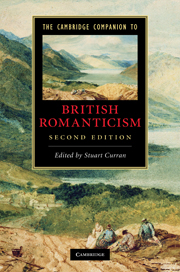Book contents
- Frontmatter
- 1 Romanticism and the “schools” of criticism and theory
- 2 Romanticism and Enlightenment
- 3 Poetry in an age of revolution
- 4 German Romantic Idealism
- 5 Romanticism and language
- 6 Culture’s medium: the role of the Review
- 7 Publishing and the provinces in Romantic-era Britain
- 8 Women readers, women writers
- 9 Romantic fiction
- 10 Romantic poetry: why and wherefore?
- 11 The sister arts in British Romanticism
- Guide to further reading
- Index
7 - Publishing and the provinces in Romantic-era Britain
Published online by Cambridge University Press: 28 January 2011
- Frontmatter
- 1 Romanticism and the “schools” of criticism and theory
- 2 Romanticism and Enlightenment
- 3 Poetry in an age of revolution
- 4 German Romantic Idealism
- 5 Romanticism and language
- 6 Culture’s medium: the role of the Review
- 7 Publishing and the provinces in Romantic-era Britain
- 8 Women readers, women writers
- 9 Romantic fiction
- 10 Romantic poetry: why and wherefore?
- 11 The sister arts in British Romanticism
- Guide to further reading
- Index
Summary
Literary study focuses primarily upon literary texts, their authors, and the historical and cultural circumstances surrounding the origin, production, and assessment of those texts. The books themselves we customarily take for granted as the raw material for critical and theoretical analysis. But for their publishers, books are commodities possessing both real and virtual “value” in the public economic sphere. However authors and scholars may choose to see things, publishing has always been a “business,” and publishers necessarily have wholly mercenary interests in the fortunes of the authors they publish. Already in the eighteenth century it was apparent that “even a sound work may depend on the publisher's exertions . . . for securing a hold on the public mind.” An author's success - or failure - was tied as much to their publishers' marketing skills as to their own literary talent. Popular success required access to an interested readership, and publishers and booksellers were the gateway through which authors had to pass. Although publishers had an obvious financial stake in the books they published, the authors were no less heavily invested. The Romantic era's greatest and most popular novelist, Sir Walter Scott, provides a good example. Although Scott had been Britain's most popular living poet, when Waverley appeared on July 7, 1814, his poetic star been eclipsed by that of the Regency's new literary sensation, Lord Byron, whose Childe Harold's Pilgrimage, cantos I and II, had appeared in March 1812, catapulting their author into immediate stardom.
- Type
- Chapter
- Information
- The Cambridge Companion to British Romanticism , pp. 153 - 168Publisher: Cambridge University PressPrint publication year: 2010



